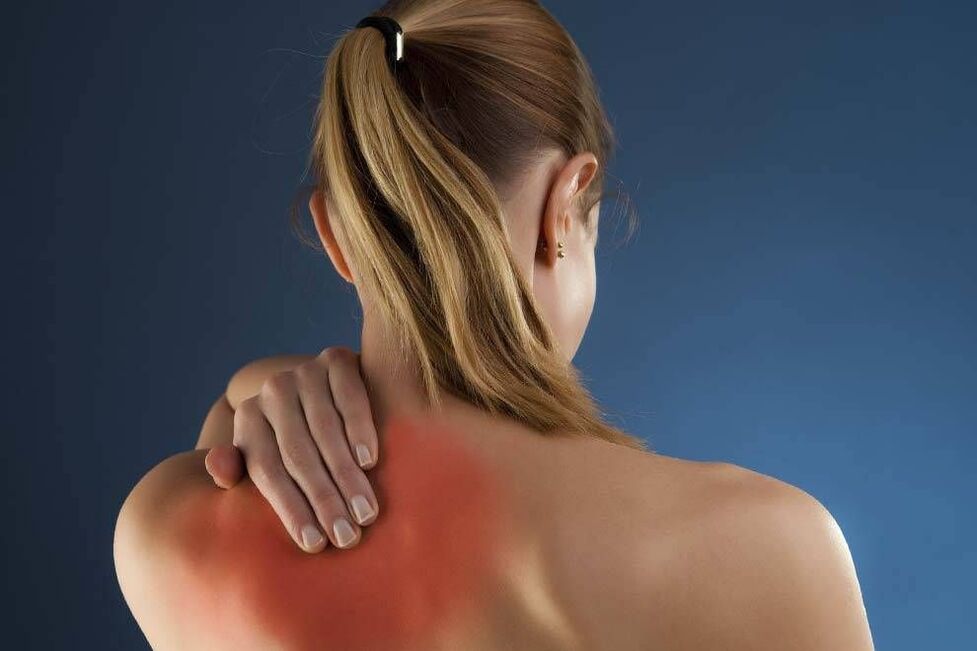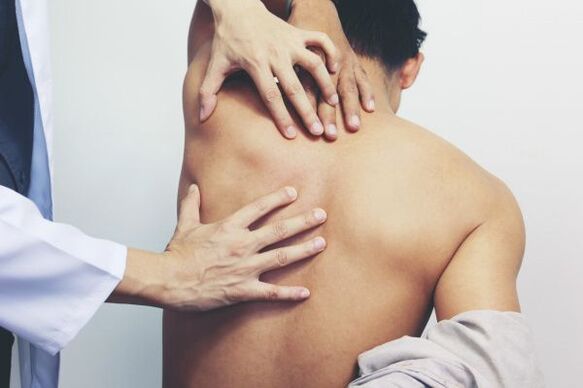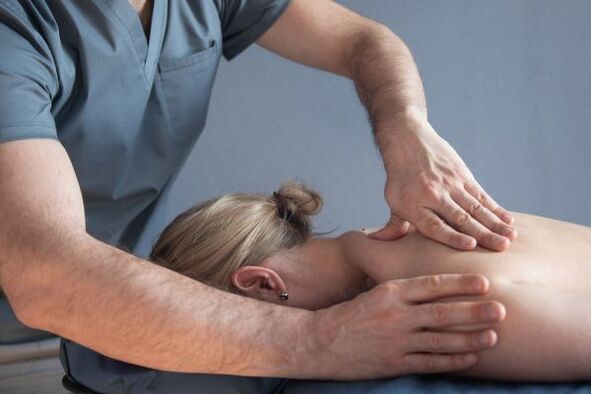
pain under left shoulder bladeObserved in musculoskeletal pathology (osteochondrosis, myofascial syndrome, injuries), cardiovascular diseases (myocardial infarction, angina pectoris, rheumatic and non-rheumatic carditis), gastrointestinal diseases (pancreatitis, stomach ulcers). Rare causes of the symptom include damage to the spleen, Includes ulcers and skin tumors. Diagnostic methods are selected depending on the underlying syndrome: X-ray, ultrasound and endoscopic examinations are used. For pain relief, analgesics are prescribed, after whichThe underlying disease is treated medically or surgically.
Causes of pain under left shoulder blade
radicular syndrome
The pathological condition develops with thoracic osteochondrosis or intervertebral hernia. Less commonly, radicular pain occurs with spondylolisthesis and ankylosing spondylitis. Acute pain in the projection of the left scapula is noted when the third-sixth thoracic roots are involved in the process. Are; Discomfort directly under the scapula indicates the localization of damage in the 7th-8th vertebra. Usually, the pain spreads from the scapula to the lateral surface of the chest and intercostal spaces.
myofascial pain syndrome
Poor posture and prolonged stay in an uncomfortable position lead to constant tension in the muscles. The syndrome manifests itself as pain in the area of the scapula on the left, when the load is mainly on this side. The discomfort the patient experiences is deep and moderately intense. At first, the pain is experienced only during movement and exertion, but over time it becomes constant. Sometimes a sharp pain appears in the forearm or left hand.
Sports injuries
Acute pain develops after a crack or fracture in the scapula or an injury to the soft tissue on this area. If the integrity of the bone is preserved, the pain is moderate, the person can take deep breaths and walk independently. When bone structuresWhen there is traumatic damage, there is sharp pain, and the mobility of the arm and shoulder girdle is often limited. Sharp pain is felt when changing position or applying pressure to the injured area.

boils and carbuncles
Purulent inflammation of the skin around the left shoulder blade is accompanied by intense pain, which, as a rule, is clearly localized. As the abscess matures, a "pulling" sensation appears, whichintensifies when the inflamed area is touched or rubbed with clothing. The pain subsides after the tire is broken and the necrotic core is exposed. With a carbuncle, the pain is more intense, and the patient's generalThe situation often gets worse.
heart disease
Heart damage is a specific cause of pain under the left scapula, which is associated with the proximity of the anatomical location and the characteristics of the infection. In this case, the symptoms are accompanied by various types of chest pain, a feeling of cold or interruption of the functioning of the heart. Tachycardia and other rhythm disturbances are usually detected. Pain under the shoulder blade appears as follows:
- myocardial infarction.Patients experience an unbearable burning sensation that spreads from the precordial area to the left arm and shoulder blade, and less frequently to the clavicle and neck area. This condition arises suddenly and is accompanied by intense fear of death and a state of unconsciousness. it occurs.
- Stable angina.Episodes of squeezing or pressing pain spreading to the sub-scapular region are typical for ischemic heart disease attacks. Unpleasant symptoms are triggered by physical activity or emotional stress and last on average 10-15 minutes. Rest or taking nitratesAfter the pain disappears.
- Inflammatory heart disease.Dull or stabbing pain in the chest, which spreads to the left shoulder blade and bothers the patient for several days, is typical for acute carditis (myocarditis, pericarditis). The person experiences shortness of breath, increased body temperature. And there is also complaint of swelling in the lower limbs.
- Arthritis.Pain radiating to the left half of the back with cardialgia is characteristic of the clinical picture of rheumatic carditis. The clinical picture is complemented by arthralgia, ring-shaped erythema and rheumatic nodules on the skin. Symptoms are more common in children and adolescents.
pancreatitis
Groin pain that radiates from the left hypochondrium to the subscapular region is observed with acute inflammation of the pancreas. In addition to the pain syndrome, patients are concerned about debilitating vomiting and tension in the abdominal muscles with impurities of bile and mucus. -The feeling of pain increases due to movement, so the person tries to lie down on his side without moving.
In chronic pancreatitis, irradiation of pain under the scapula indicates an exacerbation of the process. Most often, the violation is provoked by errors in the diet - a large feast, drinking alcohol. The pain is paroxysmal in nature, sometimes not only subscapularisspreads to the anus, but also to the precordial area. Symptoms are combined with nausea, flatulence and bleeding.
stomach ulcer
Pain under the left shoulder blade is a sign of the localization of the defect on the posterior wall of the abdomen, closer to the back. Unpleasant sensations appear within 20-50 minutes after finishing the meal. The sooner the symptoms appear, the location of the ulcer. The discomfort becomes more severe when eating sour, spicy or fried food. To reduce the intensity of pain, patients induce vomiting.
spleen disease
Pain and a feeling of fullness in the left subscapular region accompany splenomegaly caused by infectious, autoimmune or myeloproliferative processes. With gradual enlargement of the organ, periodic discomfort with heaviness in the affected area develops, and the size of the spleenThere is a sharp cutting pain under the left shoulder blade with rapid changes in .
Somewhat less frequently, the cause of pain is surgical pathology of the spleen: rupture, infarction, volvulus. In this case, there is a cutting or throbbing pain under the scapula, which is aggravated by the slightest movement. Therefore, the patient a forcedTakes the position: lying on your left side or on your back with your knees pressed to your stomach. The clinical picture is complemented by a sharp drop in blood pressure and tachycardia. In the absence of adequate pain relief, shock occurs.
bronchopulmonary pathology
Focal processes on the left side in the lungs often cause pain in the projection of the scapula. Discomfort increases with deep breathing, laughing-talking and coughing attacks. The pain has different nature: sharp, stinging, Dull, pressing. They are also accompanied by fever, shortness of breath and other typical respiratory symptoms. Most often, pain under the left shoulder blade is experienced by patients who develop:
- Pneumonia.The patient feels moderate mild pain, which has a clear localization in case of focal inflammation of the lungs or spreads to the entire scapular region in case of lobar pneumonia. A deep cough appears with the expectoration of mucopurulent sputum. Symptoms 2-4Last for weeks.
- Pleurisy. With exudative pleurisy, a person experiences pressure and tearing under the scapula and on the lateral wall of the chest. When you feel this area, the discomfort intensifies. In dry pleurisy there is swelling in the chest and sub-orbital area. There is intense pain, which increases during movement.
- Tuberculosis disease.Tuberculosis infection lasts for a long time, so pain of low intensity persists for several months. If the pain is localized in the area of the scapula, the pathological focus is more likely to be located in the posterior segments of the lung.
- Pulmonary infarction.The death of a part of the pulmonary parenchyma is manifested by severe pain that radiates under the left shoulder blade, which is clinically similar to an angina attack. The condition of patients is complicated by hemoptysis or pulmonary hemorrhage, dysfunction of external respiration and arrhythmias. It happens.
rare cause
- tumor: Osteoma and osteosarcoma, bone cyst, malignant tumors of the skin over the scapula (basal cell carcinoma, melanoma).
- rare cardiac malformation: Cardiac syndrome X, aneurysm of the descending aorta.
- acute surgical disease: Retroperitoneal abscess, hemoperitoneum, strangulated diaphragmatic hernia.
diagnosis
Patients with pain under the left shoulder blade are first sent for consultation to an orthopedic traumatologist. If there are no disorders of the musculoskeletal system, other specialists are involved in the diagnostic search: neurologist, cardiologist, surgeon, etc. To establish the causes of pain, a whole range of instrumental studies are prescribed, which include:
- Radiography.X-ray of the scapula in frontal and lateral projection allows one to exclude or confirm a traumatic injury. Radiation imaging of the spine is indicated for suspected osteochondrosis, scoliosis or spondylolisthesis. Or there may be suspicion of damage to the heart.
- Electrocardiogram.A standard 12-lead ECG is a screening method, based on the results of which the doctor makes a preliminary diagnosis and identifies dangerous processes (myocardial infarction, life-threatening arrhythmias). The diagnostic complex is complemented by classical or transesophageal echocardiography and cardiac electrophysiology. is done.
- Ultrasound of abdominal organs.A quick and non-invasive method is used to detect common conditions that cause pain in the left shoulder blade. Ultrasound examination shows signs of stomach ulcers, inflammation of the pancreas, and an enlarged spleen. EGD is used to clarify the diagnosis of peptic ulcer.
- additional methods, To clarify the nature and severity of bone changes, CT or MRI of the spinal cord is performed. In case of possible bronchopulmonary diseases, bronchoscopy with biopsy and pleural puncture is performed. If in diagnosing abdominal pathologyIf there are difficulties, diagnostic laparoscopy is recommended.
Laboratory test methods play a major role in making the diagnosis. A clinical blood test shows signs of inflammation or disruption of hematopoietic processes. Indicators of acute phase protein and proteinogram are informative in case of possible heart damage or autoimmune process. For anginal painSpecific myocardial markers are evaluated.
To diagnose gastrointestinal diseases, a coprogram is carried out: the presence of pancreatitis is indicated by a high content of undigested food particles, an increase in the number of striated muscle fibers and starch grains. Inflammatory processes of the lungs and pleuraIn case, bacteriological seeding of the biomaterial is necessary, followed by testing the sensitivity of the isolated microorganisms to antibiotics.

Treatment
Help before diagnosis
Considering the variety of causes of pain under the left shoulder blade, it is extremely difficult for the doctor to give recommendations until the underlying pathology is identified. During the examination, load on the back muscles to eliminate simple fatigue and excessive exertion. It is advisable to reduce the pain, which can cause persistent pain symptoms. If the sensations are unbearable, analgesics are used and the patient is immediately admitted to the hospital.
conservative medicine
The treatment plan is selected only after a complete diagnosis and determination of the etiological factors of pain under the left shoulder blade. If the patient suffers from severe discomfort, anti-inflammatory drugs and muscle relaxants are recommended. , which provide immediate relief from painful sensations. For severe pain, therapeutic blockade and administration of narcotic analgesics are effective. A mode of physical activity is chosen taking into account the disease.
Drug therapy is prescribed by a specialist of the appropriate profile. For pain caused by heart damage, cardiologists prescribe antianginal and antiarrhythmic drugs, antiplatelet agents and anticoagulants and antihypertensive drugs. For diseases of the bronchopulmonary system a pulmonologistRequires involvement and use of antibiotics, expectorants and specific anti-tuberculosis drugs.
For gastrointestinal pathologies, an appropriate regimen is selected and the therapy is complemented with enzyme preparations, prokinetics, antacids and antisecretory drugs. In neurology, neurometabolic agents, B vitamins, and drugs that improve blood microcirculation and rheologicalImproves properties, indicated to eliminate radicular syndrome.
For posture disorders and other problems of the spine, non-drug methods are actively used: traction therapy, therapeutic massage, exercise therapy. Among physiotherapeutic methods, balneotherapy (sulfide and radon baths), mud therapy and reflexology are popular. It is possible to increase the effectiveness of drug treatment by electrophoresis of drugs directly into the affected area.
Surgery
Surgical methods are indicated when conservative treatment is ineffective or in acute life-threatening pathology, when delay is dangerous to the life and health of the patient. The second group of operations includes stenting, angioplasty and bypass surgery for myocardial infarction. Methods include the assistance of abdominal or thoracic surgeons for injuries, purulent processes and internal bleeding.
Planned surgical interventions in neurosurgery are often prescribed for severe radicular syndrome and intervertebral hernia. To eliminate the pain associated with compression of the nerve structures, microdiscectomy and laser vaporization of the disc are performed. In rare cases, on the spinalStabilization operations are resorted to (interbody fusion, application of the Halo device, transpedicular fixation).



















































